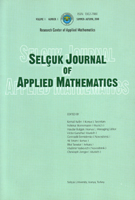|

Selçuk Journal
of
Applied Mathematics
Summer-Autumn, 2000
Volume 1
Number 1
Research Center
of
Applied Mathematics
|
|
SJAM
Summer-Autumn 2000, Volume 1 - Number 1
|
|
Adaptive
Hierarchical Tenzor Product Finite Elements for Fluid Dynamics
|
|
S.-A.
H. Schneider, Christoph Zenger |
|
Institut für Informatik, Technische Universität München, D-80290
München, Germany
email: schneids@in.tum.de
; zenger@in.tum.de
Received: August 10, 2000
To
Prof. Dr. Chr. Zenger 60-th birthday
|
|
Summary
This article is a contribution to the current research field of computational fluid dynamics. We discretize the Stokes flow for Re=0 with adaptive hierarchical finite elements and verify the method with numerical results for the three-dimensional lid-driven cavity
problem. In order to solve the corresponding Stokes problem, we replace the constraint of the conservation of mass by an elliptic boundary value problem for the pressure distribution p.
Consequently, the solution of the Stokes problem is reduced to the solution of d +1 Poisson problems, the so-called successive poisson scheme. We use the hierarchical tensor product finite element method for the numerical solution of the Poisson problems as a basic module. On
one hand, this allows a straightforward approach for the self-adaptive solution process: We start with a regular discretization and create new elements, where the hierarchical surplus of the weak divergence indicates the need to refine. On the other hand, we use multigrid concepts for the efficient solution of the large linear systems arising from the elliptic differential equations. The discussed example shows that the use of elements with variable aspect ratio pays off for the resolution of line singularities.
|
|
|
|
Key
words
hierarchical finite elements, lid-driven cavity, sparse grids, successive poisson scheme, Stokes flow, tensor product approach
|
|
Mathematics Subject Classification (1991):
65N22,
65N30, 65N50, 65N55
|
|
Article
in PS format (3843 kb) |
Article in ZIP
format (698 kb) |
|


